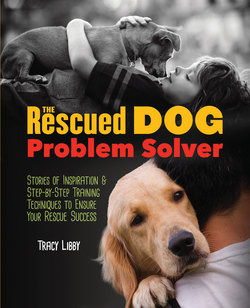Читать книгу The Rescued Dog Problem Solver - Tracy J. Libby - Страница 3
На сайте Литреса книга снята с продажи.
ОглавлениеIntroduction
The fact that you’re reading this book probably means that you have adopted—or intend to adopt—a shelter/rescue dog. That, in turn, means your life is about to change for the better!
Dogs demand a lot of attention—some more so than others, depending on their breed, history, temperament, and personality. Yet dogs pay us back with an endless range of benefits. The obvious perks include companionship and lower blood pressure, but what about the silliness that is so contagious it practically oozes out of some dogs’ fur? Do you ever want to break out in a happy dance at your dog’s pure happiness? Maybe gazing at his goofy, lovable face makes you grin uncontrollably from ear to ear? What about the wiggly dog who cheers up even the crummiest of days? And don’t forget the dog who makes you cry happy tears for being nothing short of perfect. These magic moments are what make loving dogs super special. Unbreakable bonds between dogs and owners are created in these moments, and they make being in the company of dogs a blessing.
Although dogs are incredible creatures, giving you the impression that it’s all clear sailing ahead would be disingenuous. Sure, your dog will make you laugh harder than you ever imagined, but he may also potty on your best carpet, commit heinous crimes against your personal property, refuse to come when called, and embarrass you in front of your in-laws. (If you were looking to avoid public humiliation, you should have considered a cat!)
My primary motive for writing this book is to share with you the amazing journey of twelve shelter dogs who were facing uncertain futures. Yet through the love and dedication of their equally remarkable owners, as well as plenty of committed volunteers who saw past their often sad, sunken exterior, these dogs are now living a life of endless kisses, cuddles, and love. Some, like Lily Bella, Queso, and Casey, have gone on to be perfect hiking, jogging, camping, or horse backing riding companions. Others, like Kota and Levi have excelled in canine sports. All of them were at one time discarded, lost, or abandoned, yet they have become treasured companions in the eyes of their owners.
So what will you find in this book? In addition to the personal journey of these twelve remarkable rescue dogs, you will find lots of material that will help you to build a mutually respectful and loving human-canine relationship (because everything about dog training comes down to the relationship you have with your dog). You will learn about the “transition period”—that period of time, which can be a few days, weeks, or months—when your dog may be nervous, anxious, fearful, and really not himself as he adjusts to his new home. You’ll learn the benefits of interactive play and how to use it to build confidence and enthusiasm and instill desired behaviors or to physically and mentally burn excess energy and tire out a high-energy dog. You will also learn how to teach basic obedience commands and fun tricks, as well as to problem solve solutions.
I hope you will also learn to look at your own emotions and traits to determine your behavior, which has a huge impact on your dog’s behavior. If, for example, you are harsh and overbearing, unsympathetic, insecure, impatient, arrogant, pessimistic, and so forth, you will have a profoundly negative effect on your dog. If, on the other hand, you are funny, silly, animated, invigorating, upbeat, kind, patient, and so forth, you will have a positive effect on your dog.
Finally, plenty of wonderful methods for training dogs exist, and I have endeavored to share many of them with you. Throughout the book, I have reinforced the use of positive reinforcement. Granted, positive reinforcement doesn’t necessarily mean being nice, it simply means adding something that your dog finds reinforcing, such as cookie or toy, and, although other options exist, I think you will find positive reinforcement serves you well in most instances.
Whether you start with a puppy, junior, or adult dog, the same principles of training apply because behaviors are shaped by repetition and by building each lesson on the previous one, step-by-step. The length of time a dog can train or the rate at which he learns will vary depending on his age, temperament, energy level, history, owner involvement, and so forth. Consider, for example, that a training session for an eight- or ten-week-old puppy may be two or three minutes several times a day. Yet, a five- or six- month-old dog can usually work for ten or fifteen minutes several times a day, whereas a high-drive, high-energy dog will most certainly need more than a ten-minute stroll around the block!
My hope is that this book will inspire and help you to build a zany, happy, mutually loving and respectful human-canine relationship. Most of all, I hope to make training fun for both you and your dog. After all, if there’s no joy in it, what’s the point?
As you read, no doubt you will come across some ideas that you love and others that seem questionable or downright nutty. You may find that some tools, techniques, and solutions will work for you and that some will work better for others. That’s okay. As you build your own mosaic of knowledge, your job as a responsible dog owner will be to sort through the myriad training techniques and pick those that work successfully for you and your dog. It is my hope that, by the end of the book, you have lots of options to choose from and you can tailor your training methods to fit your dog’s specific needs. Section I: In Your Kitchen
